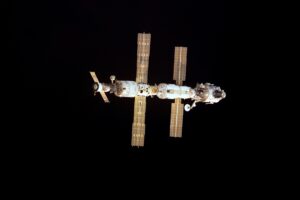Op-ed | 20 years in space: Lessons in cooperation from the International Space Station
By Brian Berger

Twenty years ago, the joint U.S.-Russia space mission Expedition 1 docked with the first modules of the International Space Station (International Space Station). An American astronaut and two Russian cosmonauts arrived to, in effect, bring the station to life. They turned on the lights, unpacked the boxes, and set up the kitchen. Over 136 days and two Space Shuttle deliveries with more International Space Station modules, the pioneers of Expedition 1 began two decades of continuous human habitation in space.
Since that flight, some 240 people from 19 countries have lived and worked on the International Space Station. The station has hosted thousands of experiments encompassing biology, physics, technology, Earth science and more. If you watch on a clear night, you can see it with your own eyes, and it is poetic that the third brightest point in the night sky is a shining reflection of what we can do when international cooperation and ambition meet in space.
Today, our gaze on what’s possible looks far beyond the ISS’s low Earth orbit. Empowered with the same collaborative vision that made the International Space Station a success, NASA’s Artemis program is part of a global, multinational effort to return to the Moon and do so in a sustainable way. Regular exploration and experiments near and on the Moon are the next steps in our space journey, and it is inspiring that 20 years after the International Space Station began full operations, eight nations joined the Artemis Accords. In October, the United States, along with Australia, Canada, Italy, Japan, Luxembourg, the UAE and the UK, signed a set of agreed principles for how we will cooperate in our collective lunar exploration.
The accords are the foundation for how we craft the multilateral agreements and construct the complex missions ahead. While this is exciting from the perspective of exploration and research, it is equally valuable in what it means for humanity’s future in space and on Earth. The more we cooperate in space, the better able we are to cultivate and preserve peaceful relationships. The Artemis Accords are open to other nations who also might sign-on, and there is every reason to feel confident that our next push to the Moon will directly contribute to a collaborative, harmonious global community.
Investments in a Better Future
A common question that is sometimes put to space agencies and professionals is, with so many problems on Earth, is investment on space exploration worth it? It is true that the troubles the world has faced in 2020 underscore the broader trends challenging our planet. Climate change, public health, economic growth, jobs creation, education, and peace and diplomacy — these are enduring priorities for all nations, and at face value, they don’t seem to have much in common with space.
What the International Space Station has made clear, however, is that when we open space to more people, countries and industries, opportunity and innovation flourishes. The International Space Station microgravity environment has permitted basic science research that reveals a deeper understanding of the natural environment. At the outset of basic research, it is seldom clear how the impact of scientific insight will cascade into real-world benefit. It is a long, meandering road from hypothesis to the “next best thing.” Yet, this is why space is inherently exploratory. We cannot know what benefits await us unless we go in search of them.
Consider that when the novel coronavirus first spread in the United States and demand for ventilators threatened to overwhelm our limited supply, NASA’s Jet Propulsion Laboratory (JPL) developed a COVID-19-specific ventilator in just 37 days. JPL is principally a space technology organization, not a health care manufacturer, and yet, facing urgent need, it drew from the processes and technologies developed for space to create lifesaving tools for Earth at astounding speed. This is how space research directly impacts life on Earth, and it does so across every industry and field.
In this way, funding space programs isn’t just spending; it is a national investment. And to be sure, we do not need to declare mission success before the rewards of space are realized. We have not even launched Artemis 1, the first integrated flight of the launch system that will carry humans and materials to the Moon, and already we are seeing substantial economic benefit from the effort. In 2019, NASA’s Moon to Mars exploration efforts (which include the Artemis program) generated more than $14 billion in economic impact and supported more than 69,000 jobs, according to a recent study. Overall last year, NASA’s total economic output was more than $64.3 billion, supporting more than 312,000 jobs and yielding $7 billion in taxes.
After 20 years of uninterrupted human presence in space, we know that international collaboration and innovating to survive in the harshest environments yields powerful technological advancements. As we look back on two decades of International Space Station operation and look ahead to missions to the Moon and beyond, the lessons learned are many, but perhaps one is clearest of all: no one goes to space alone, and when we go together, we build a better Earth for all.
Thomas E. Zelibor, Rear Admiral, USN (Ret.) is CEO of Space Foundation, a 501(c)(3) global space advocate headquartered in Colorado Springs, Colorado.
November 2, 2020 at 10:39AM
via SpaceNews read more...

Post a Comment